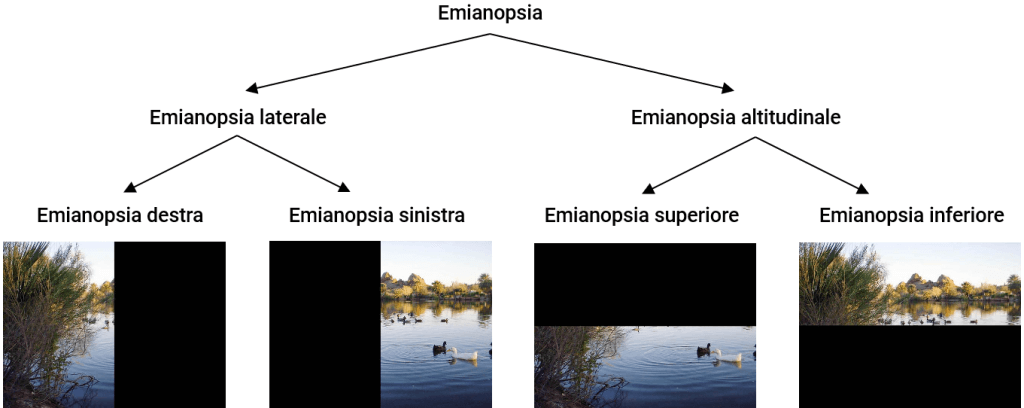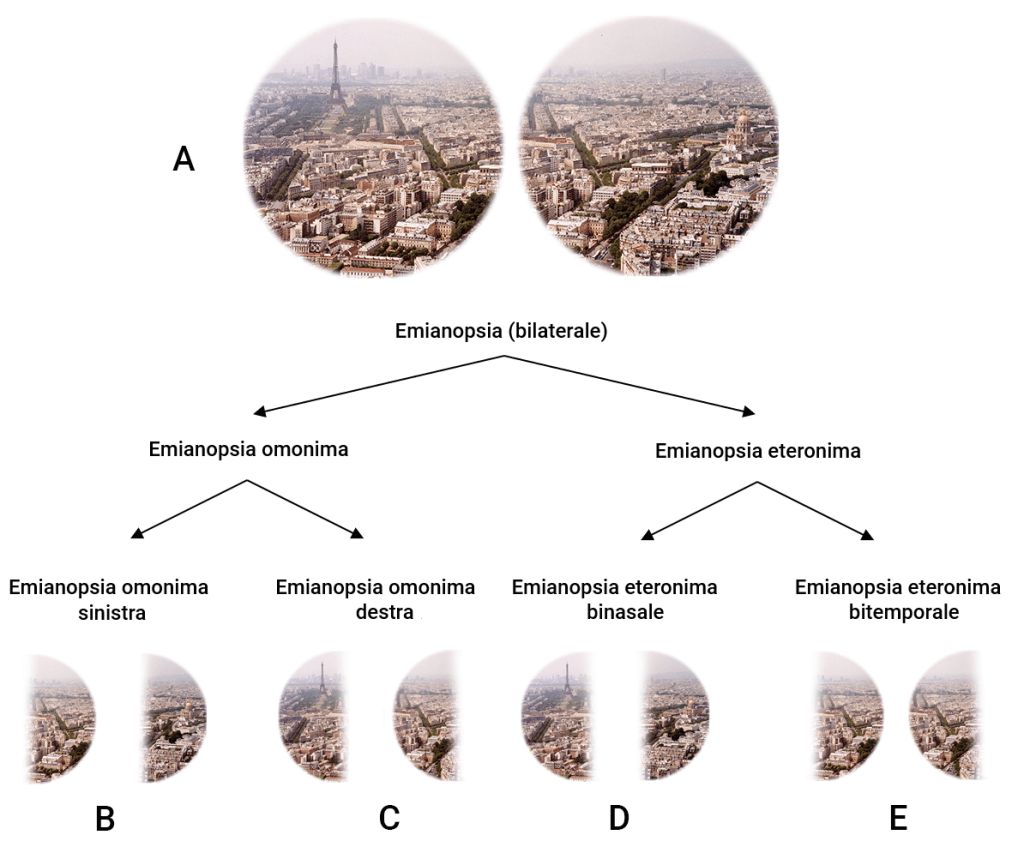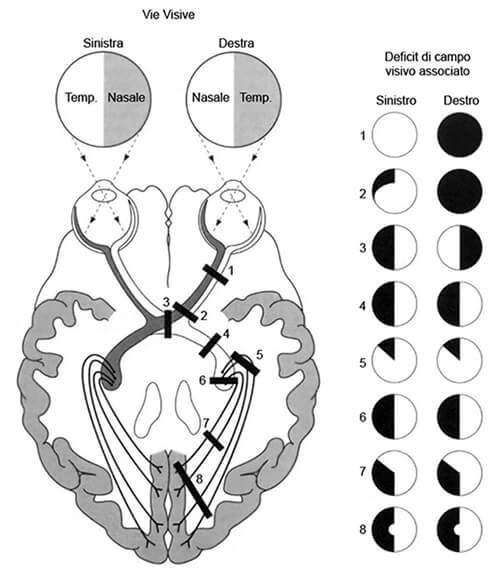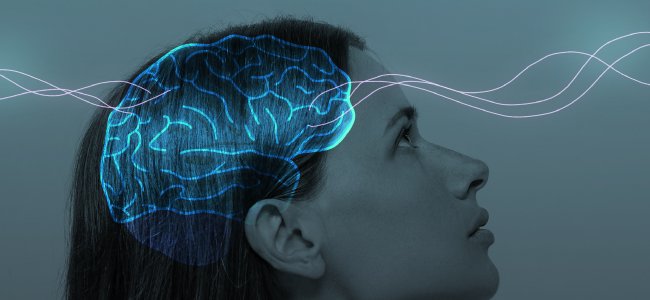Types of Hemianopias

Definition of hemianopia
The term hemianopsia, or hemianopia, indicates the abolition of one half of the visual field, where visual stimuli are not perceived. The meaning is well evidenced by the etymology of the term, composed of “hemi-” (half), “an-” (without) and “-opsia” (sight).
To understand what limitations this type of visual field deficit entails, we need only close one eye and visualize an imaginary line, vertical or horizontal, crossing the scene we can see by passing through its center; by imagining that everything on one side (above, below, left or right) of the line itself cannot be observed we have an idea of what a subject with hemianopia would see.
Classification
The line separating the seen and unseen portions of the visual field may be vertical or horizontal, which allows us to introduce a first criterion for classifying hemianopia: lateral or vertical hemianopsia and superior or inferior hemianopia.
It is obvious at this point to make a further subdivision, distinguishing in the first case between right hemianopia (Figure 1a) and left hemianopia (Figure 1b) and, in the second, between superior hemianopia (Figure 1c) and inferior hemianopia (Figure 1d).

It is not uncommon to find cases of incomplete hemianopia, in which a complete half of the visual field is not missing, but instead an additional portion is preserved. In these cases, “sparing” is often referred to; for example, “macular sparing” refers to maintaining the function of the central portion of the visual field, corresponding to the fibers originating in the macular area of the retina (Figure 2).

The impairment may also affect only one quadrant of the visual field; the condition found is described as quadrantanopia (Figure 3), along with an indication of which quadrant is involved.

If we are in the presence of a hemianopia with “sparing” of a sector that, adjacent to the healthy portion of the visual field, widens from the center of it toward its periphery, we may find intermediate situations between a hemianopia and a quadrantopsia, closer to the former or the latter condition depending on the extent of the sector itself.
Not mentioned so far is the fact that starting from a structure called the optic chiasm, nerve fibers originating in the temporal portion of the retina of the right eye accompany those from the nasal portion of the left eye to the right portion of the brain, and vice versa. In this way to the right occipital area of the brain comes visual information corresponding predominantly to the left portion of the binocular visual field and to the right occipital area that corresponding predominantly to the left portion.
This peculiar organization results in an interesting consequence with regard to the classification of hemianopiasis: chiasmatic and retrochiasmatic lesions (i.e., located at and behind the optic chiasm) typically affect both some fibers coming from the left eye and others coming from the right eye; therefore, we will be able to classify the resulting hemianopiasis according to the reciprocal relationship between the deficits found in the two monocular visual fields.
Since, as described, retinal fibers with nasal and temporal origins (thus roughly separated by a vertical line) are bound to take different paths, these considerations apply particularly to lateral hemianopias.
We shall then distinguish between:
- homonymous hemianopia (or homonymous hemianopsia), when impairment of the same side of the visual field of each eye is observed
- heteronymous hemianopia, when the impairment in the visual field of one eye is opposite to that found in the visual field of the other eye (these designations can also be used to describe quadrantopsias).
Depending on the missing portion of the visual field we will be able to further distinguish between:
- left (Figure 4b) or right (Figure 4c) homonymous hemianopia with impairment of the right or left portion of the visual field of both eyes, respectively
- binasal hemianopia (Figure 4d) rarer, impairs vision of the left portion of the visual field of the right eye and the right portion of the visual field of the left eye; subjectively, the affected patient has difficulty seeing what is positioned in front of him or her
- bitemporal hemianopia (Figure 4e), which is more frequent, impairs vision of the temporal portions of each eye’s visual field; subjectively, the patient has difficulty, for example, detecting objects and obstacles positioned in the periphery, either to the right or left.

The link between these types of hemianopias and optic chiasm pathologies is described in more detail in the article Hemianopsia and Optic Chiasm Pathologies, where we point out how the presentation of the different types of visual field deficits are closely related to the location of the lesion that caused them.
For example, the image below (Figure 5) schematically shows the visual field alterations most frequently observed as a consequence of optic pathway damage (for simplicity, lesions are shown only on the right, as well as, centrally, at the optic chiasm).

Finally, it may be useful to distinguish between temporary hemianopia (e.g., in cases where it occurs only during episodes of migraine with visual aura) or permanent, congenital or acquired, with acute or progressive onset.
Conclusion
The classification of hemianopias, essentially related to the identification of the impaired visual field area, is useful in at least three respects in addition to purely descriptive purposes:
- makes it possible to predict the greatest difficulties the patient may face, e.g., which obstacles will be more complicated for him to locate, whether during reading it will be more challenging to follow the line or to go to the head, etc;
- makes it possible to locate the anatomical areas where the lesion responsible for the deficit is most likely to be located;
- given the previous consideration, it may suggest some of the causes most likely to have led to the initial lesion (stroke, cerebral ischemia, meningitis, trauma, brain tumors, pituitary tumors, multiple sclerosis, etc.)

You are free to reproduce this article but you must cite: emianopsia.com, title and link.
You may not use the material for commercial purposes or modify the article to create derivative works.
Read the full Creative Commons license terms at this page.









